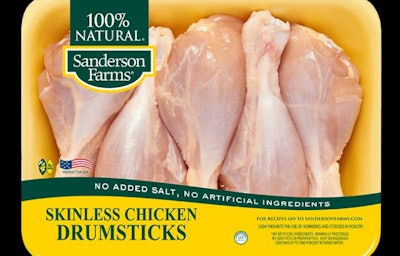
Sanderson Farms on December 17 reported results for the fourth quarter and fiscal year ended October 31.
Net sales for the fourth quarter of fiscal 2020 were $940.0 million compared with $906.5 million for the same period a year ago. For the quarter, the company reported net income of $27.9 million, or $1.26 per share, compared with a net loss of $22.9 million, or $1.05 per share, for the fourth quarter of fiscal 2019.
Net sales for fiscal 2020 were $3.564 billion compared with $3.440 billion for fiscal 2019. Net income for the fiscal year totaled $28.3 million, or $1.27 per share, compared with net income of $53.3 million, or $2.41 per share, for last fiscal year.
Executive commentary
“Over the course of the fourth quarter and fiscal year ended October 31, 2020, our company and industry faced extraordinary challenges caused by the COVID-19 pandemic and the unprecedented social and economic impact the virus continues to have on the United States,” said Joe F. Sanderson, chairman and chief executive officer of Sanderson Farms, Inc. “Through our diligent efforts to implement protocols designed to keep our teams and communities safe, and our ability to shift our production to the highest demand areas, our operations have continued to perform well and have helped to feed American families and maintain the U.S. food supply during the pandemic. I must thank our employees, our contract poultry producers, our customers, our vendors, the consumers who buy our products and the communities and states in which we operate for their hard work, dedication and perseverance during these unprecedented times. I am so very grateful for everyone associated with Sanderson Farms for rising to the challenges of 2020.
“While demand from our food service customers has remained under pressure, demand for chicken products sold to retail grocery store customers remained strong through the end of the fiscal year. We believe these conditions will continue until consumers return to restaurants and resume dining away from home in large numbers. Therefore, we are continuing to shift our production toward the tray packs that are in high demand in the retail grocery market.”
Sanderson continued, “We are confident in our ability to continue to execute our organic growth strategy and enhance value for our shareholders and other stakeholders. As such, our Board of Directors recently increased our cash dividend and extended our share repurchase plan.
“For the fiscal year, we reported record volume of poultry products sold of 4.81 billion pounds, compared to 4.53 billion pounds in fiscal 2019. Grain prices were slightly lower during fiscal 2020 compared with prices paid in fiscal 2019, and feed costs in processed flocks were lower by 3.4 percent.”
According to Sanderson, overall realized prices for poultry products were 0.4 percent lower in fiscal 2020 compared with prices last year. Boneless breast meat market prices averaged 2.8 percent higher in the fourth quarter than the prior-year period. For the full fiscal year, boneless breast meat market prices were 4.3 percent lower compared with fiscal 2019. Jumbo wing market prices averaged $1.89 per pound during the fourth quarter of fiscal 2020, up 9.0 percent from the average of $1.73 per pound during the prior-year period. Jumbo wing market prices averaged $1.61 per pound during the fiscal year, down 6.6 percent from the average of $1.72 per pound for fiscal 2019. The average market price for bulk leg quarters decreased approximately 42.8 percent for the fourth fiscal quarter of 2020 compared with the fourth fiscal quarter of 2019, and decreased 20.6 percent for fiscal 2020 compared to fiscal 2019. Cash prices for corn during the fourth fiscal quarter decreased by 15.2 percent, while soybean meal cash prices were higher by 4.7 percent. For the full fiscal year, cash corn prices were lower by 3.8 percent, and soymeal cash prices were lower by 0.5 percent when compared to fiscal 2019.
“Prices paid for feed grain during fiscal 2020 were lower when compared to fiscal 2019, representing the eighth straight year of relatively flat or lower grain costs. However, we expect feed grain costs to increase in fiscal 2021. The USDA has lowered 2020 corn and soybean crop yield estimates and has increased its estimate of export demand. As a result, market prices for both corn and soybeans have moved significantly higher since September. If we priced all our remaining fiscal 2021 feed grain needs at current prices, costs for corn and soybean meal during fiscal 2021 would be $193.2 million higher than during fiscal 2020, based on fiscal 2020 volumes. However, we have priced only one week’s supply of our January soybean meal needs and have not priced any other grain needs past December 31, 2020.
“As of October 31, 2020, our balance sheet reflected $1.85 billion in assets, stockholders’ equity of $1.42 billion and net working capital of $354.0 million. We believe our balance sheet provides us with the financial strength to both support our organic growth strategy and consistently manage our operations through the cycles that characterize our industry. We continue to evaluate a new site as part of our next phase of organic growth, and we hope to be in a position to announce the location and begin work on a new poultry complex during the first half of calendar 2021,” Sanderson concluded.















